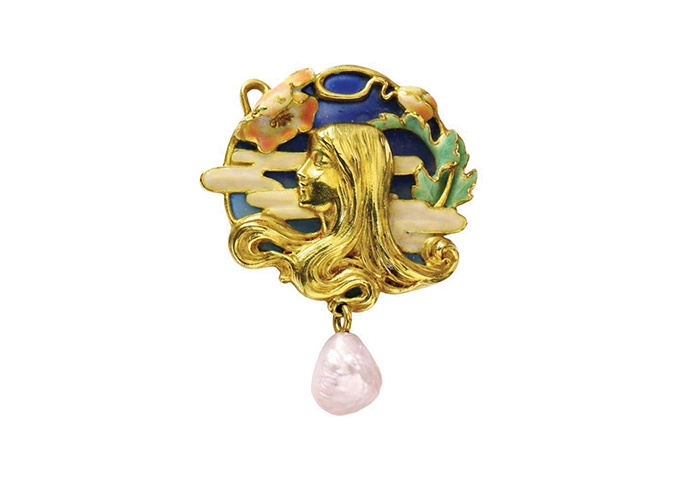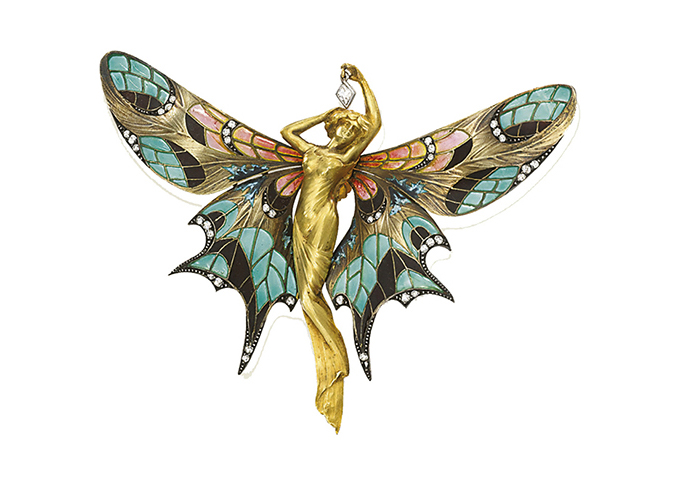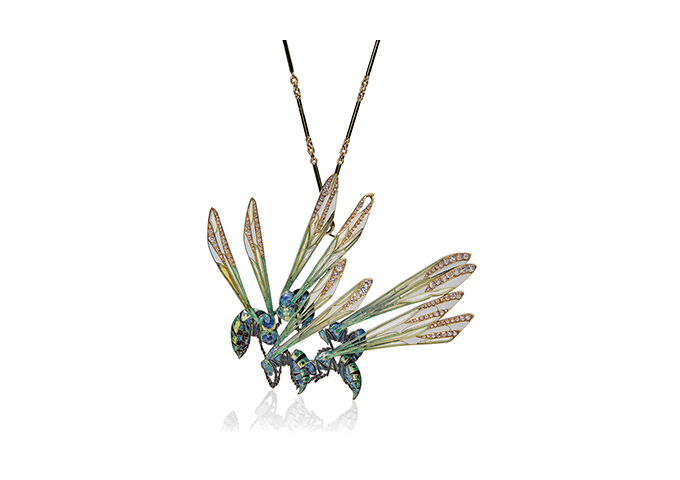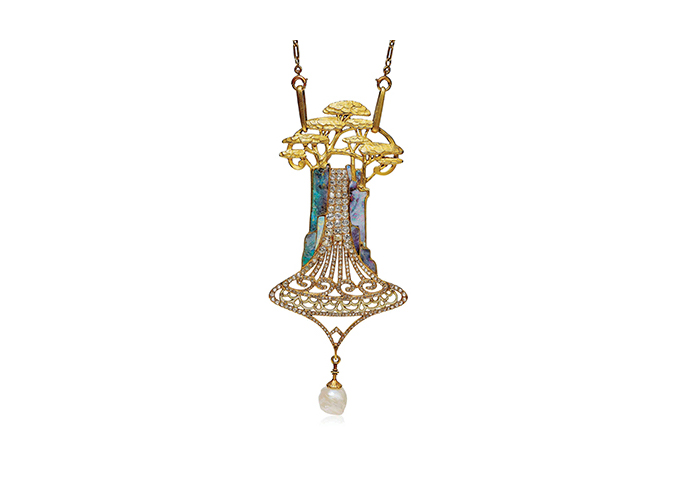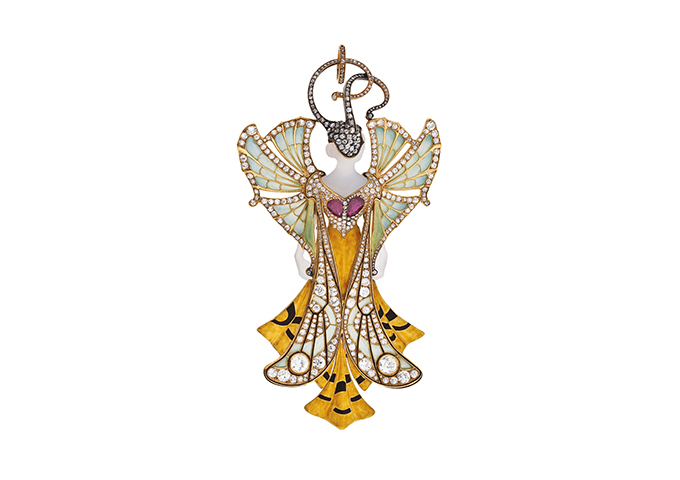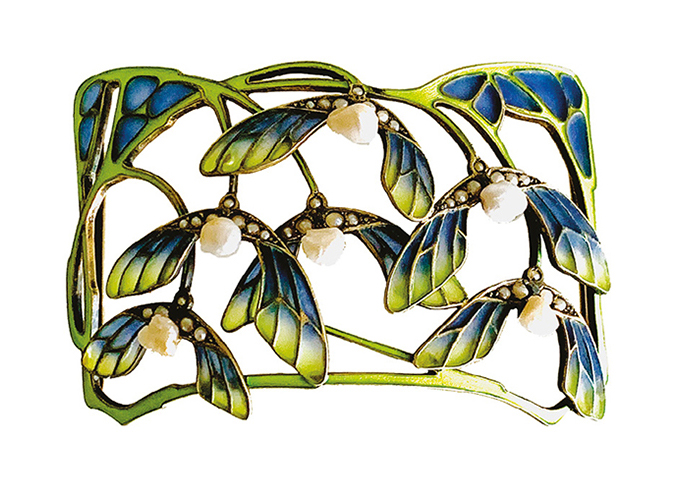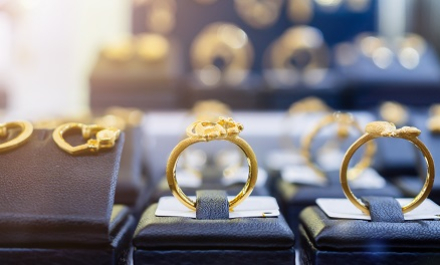Organic, fluid and dramatic, Art Nouveau pieces are consistently in vogue among jewellery lovers and collectors. JNA examines the essence, techniques and evocative appeal of this design movement.
One of the most popular categories of jewellery today is a throwback to earlier times. Antique jewels are not only beautiful, they are also unique, filled with historical significance and genuine value. For the environmentally conscious consumer, the wearer becomes someone who conserves rather than consumes. Among the many styles of these bygone eras, Art Nouveau jewels, with their organic lines, mystical motifs and natural forms, are certainly among the most endearing and enduring.
Beginning in the mid-1890s, the Art Nouveau period swept through decorative arts, architecture and jewellery, only to fade two decades later with the outbreak of World War I. Although it was short-lived, this era was fabulously creative and decidedly French. But versions of this new style also flourished in other countries. Germany and Austria had their Jugendstil; Italy had its Floreale; and Britain had its Glasgow Style.
“Its name means ‘New Art’ in French,” explained Ioannis Alexandris, antique jewellery expert and CEO of Gemolithos, which has offices worldwide. “It can be traced back to an art gallery in Paris owned by Samuel Bing that he reopened in 1895 under the new name of La Maison de l’Art Nouveau. For its grand opening and in keeping with the new taste that mixed Chinese and Japanese works of art with contemporary Western pieces, Bing featured artists who would form the core of this new design style. The name caught on and a movement was born.” What set Art Nouveau jewellery apart from earlier periods was the way it broke from the revivalist style of the 19th century that was considered “the tyranny of the diamond.”
“As with many of the great artistic movements of their time, Art Nouveau was reactionary, a fight against all that had come before, in other words, heavy Victorian gothic and pastiche, imitating revivals of all things antiquated, classical and the industrialisation of design,” added Geneva-based jewellery expert and historian Helen Molesworth. “Art Nouveau was completely organic, fluid and valued the aesthetic of original art over intrinsic value and expectation.”
Motifs and materials
The dominant themes of Art Nouveau jewels were nature – flora, fauna, insects – and the feminine figure, as well as colourful landscapes. In the realm of the botanical, flowers and plants took on a new dimension in the hands of Art Nouveau creators. “Floral motifs now had the quiver of life. Petals seemed to bend with a breath of air; roses withered; lilies curved in sensuous melancholy,” added Alexandris. “Particularly fascinating were orchids that became almost surreal.”
The feminine motif, often sensual, occupied an important place in this new movement. At the end of the 19th century, in reaction to male dominance in all walks of life, the role of women began to change, and this evolution was reflected in the new artistic designs of the era. As they became more conscious of their new position in society and more assertive with their femininity, “women were not ashamed to adorn themselves with jewels depicting the feminine form in all its beauty and sensuality,” Alexandris noted. The feminine figure was also transformed in endless ways by transposing it into mystical and colourful fairies and nymphs, adorned with butterfly or dragonfly wings, often sporting claws, adding to the dichotomy of the design.
In the world of fauna and insects, other important themes in Art Nouveau were peacocks, snakes, dragonflies, butterflies, wasps and even bats, as well as myriad other animals and birds, including mythical serpents, dragons and griffins.
While perhaps a rather unlikely theme given their undeserved negative reputation, bats were depicted in Art Nouveau paintings, decorations and jewels.
“The bat evokes many meanings,” explained Marie-Laure Cassius-Duranton, Paris-based art historian and expert on vintage jewellery. “In China, it is a symbol of happiness, carnal love and longevity. In the Western world, while its significance is more ambiguous, it also symbolises melancholy, with an inference to the night.”
One of the more prominent bat interpretations was René Lalique’s decoration for his showcase at the 1900 Exposition Universelle, as well as a bat ring, both of which are in the Musée des Arts Décoratifs (MAD) in Paris. “The association of the bat with blue enamel (blue is also the colour of melancholy) and a heart-shaped moonstone on Lalique’s bat ring makes perfect sense,” she added.
Probably the most obvious characteristic of the Art Nouveau style is the flowing whiplash line. “It was used to suggest movement and was an interpretation of the shapes and lines found in plants, a woman’s hair, feminine curves – essentially everything that moved, waved and undulated in nature,” explained Suzanne Martinez, co-owner of Lang Antiques in San Francisco.
In terms of materials, Art Nouveau jewellers focused more on the creativity and originality of the design and its craftsmanship than they did on the materials. “They valued the aesthetic of original art over intrinsic value and expectation. This also explains the importance of glass and enamel in jewellery – a revulsion against traditional value (‘just’ gems) in jewellery,” noted Molesworth.
According to Martinez, jewellers captured the iridescence on the wings of a dragonfly or imitated the ripple of water on a pond, the shimmer of a wing in flight, the colour of an orchid or the scales of a dragon by using all kinds of enamel techniques, especially plique-à-jour, as well as the use of unusual material such as horn with patina, shimmering pearls and coloured gemstones that imitated the hues in nature.
Alexandris agreed, “In the hands of Art Nouveau artists, the butterfly metamorphosed into a dragonfly with wings so real that the insect might at any moment flutter to life and fly away. The play of light through the insect’s enamelled gossamer wings is captured in translucent plique-à-jour enamel. To emphasise movement, the wings were often set en tremblant, a French term used to describe pieces with a trembling effect that was produced by elements on wires or springs.”
Other techniques were used masterfully in new ways to add mystery and depth to a piece, such as champlevé enamel and pâte de verre, a type of glass that could be worked to make it appear like a gemstone.
The artists and the auctions
Some of the most important contributors to the Art Nouveau jewellery aesthetic in France were Henri Vever, Georges Fouquet, Lucien Gaillard, Gaston Lafitte, and of course, René Lalique. Among many others were Masriera in Spain, Philippe Wolfers in Belgium, Wilhelm Lucas von Cranach and Theodor Fahrner in Germany, Ella Naper in the UK and the American companies Tiffany & Co and Marcus & Co.
Cassius-Duranton cited Henri Vever (1854-1942) as one of the main leaders of the Art Nouveau movement. She said, “Among his remarkable creations is the Sylvia pendant, a spectacular 12cm-high piece, showing the arabesques and hybridisation between the insect and the female figure. It was one of the most famous pieces showcased at the 1900 Exposition Universelle in Paris, winning a Grand Prix.” Sylvia is now part of the Art Nouveau collection at the MAD in Paris.
“Georges Fouquet (1862-1957) took his father’s company to new heights as one of Art Nouveau’s important jewellers, by using opals, enamel over chased gold and coloured stones to produce his jewels, while Lucien Gaillard specialised in plaques de cou, hair combs and pendants. Influenced by Japanese style, Gaillard worked with horn, enamels, opal and coloured stones in his designs, before eventually specialising in patination,” said Martinez.
“The maestro of Art Nouveau jewellery was René Lalique. His designs were, and still are today, completely unmissable. Flora and fauna – especially peacocks, dragonflies, insects, flowers, foliage, and his emblematic nude figures – were set in glass and enamel as a priority, with diamonds and gems usually as accents,” explained Molesworth. “He also successfully made the transition from Art Nouveau to Art Deco, becoming even more famous for his pure glass works in the 1920s
and 1930s.”
“A true innovator, René Lalique possessed an extraordinarily fertile imagination,” added Alexandris. “His spectacular pieces are brilliant, technically incomparable and startling in their originality and sensuality. His jewellery provided imagery at its most magical and evocative.”
Beginning as a revolution in the interpretation of design, Art Nouveau spread to all disciplines, from art to architecture, from fashion to furniture, from objets d’art to jewellery, where designs embodied an emotional depth not seen in other jewels. Although the movement ended in the first two decades of the 20th century, Art Nouveau has seen a remarkable renaissance in the first two decades of the 21st century. Copies of these jewels abound, while the original pieces, signed and unsigned, show up regularly at auctions, with prices continuing to climb. In 2017, Christie’s even devoted an entire sale to magnificent Art Nouveau pieces, some of which sold above their highest estimates.
With its softness, organic elegance and mystical romanticism, Art Nouveau jewellery will continue to be enjoyed by millions of people around the world.




